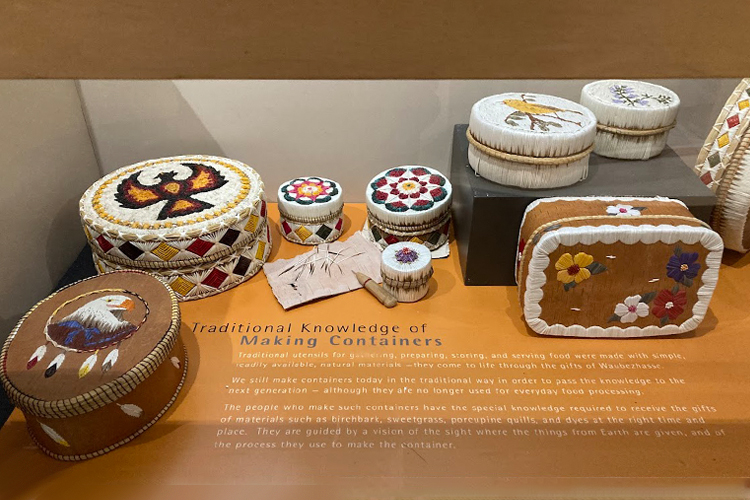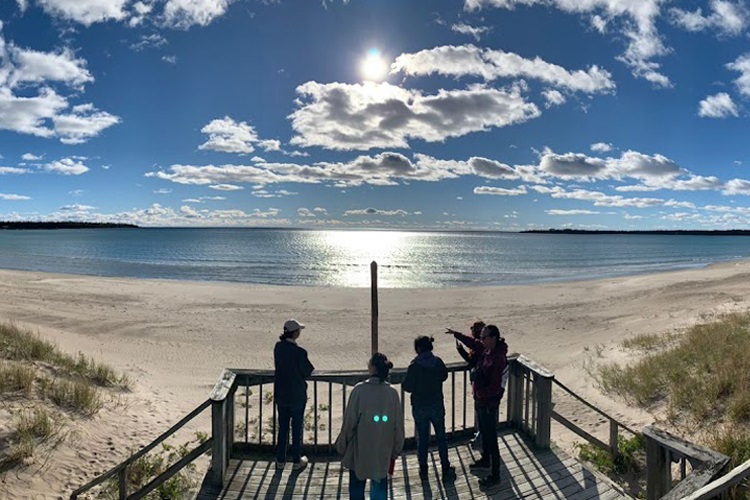“The collecting of the past does not have to be the collecting of the future.”
This phrase resonated with Hillary Chan, a first-year anthropology graduate student specializing in North American archaeology, Indigenous archaeology and decolonization. She heard this during a visit to the Bruce County Museum and Cultural Centre (BCM&CC) in Southampton, Ontario.
She joined nine other anthropology graduate students on a week-long Indigenous Course Module field trip this fall for her Archaeology in Contemporary Society (ANT4010) course, which explores the role of archaeology in modern culture.
Indigenous Course Modules enable both undergraduate and graduate students to participate in experiential learning opportunities that deepen their understanding of Indigenous peoples, knowledges, histories, cultures, languages and the impacts of colonization.

In addition to the BCM&CC, students spent time with Indigenous archaeologists, historians and heritage professionals from the Saugeen Ojibway Nation Environment Office, the Ojibwe Cultural Foundation (OCF) on Manitoulin Island, Shebahonaning in Killarney, Ontario, and Georgian Bay Islands National Historic Park.
At each site, the students discussed how these places have been represented to the public historically, and how Indigenous community members understand these places and care for them.
“Each person we learned from encouraged the class to look to the future and how we can support Indigenous management of their heritage,” says Chan.

“We had students coming from all over the place, so for many, they were seeing Northern Ontario for the first time,” says Alicia Hawkins, an associate professor of anthropology at the University of Toronto Mississauga, who taught the course and organized the trip.
“They were learning about treaties they didn't know about — and important things that all Canadians should know about, like the Indian Act, Bill C-31 and residential schools.
“It was intense, it had high points and low points. Some of the low points were important because they were points of discussion, places where there are things we feel need to be worked on.”
One of the high points was spending time at the Ojibwe Cultural Foundation, working with OCF’s archivist, Naomi Recollect, to assist in cataloguing ancestral belongings in their archaeological collections.
Established in 1974, the OCF was created to preserve and revitalize the language, culture, arts, spirituality, and traditions of the Anishinaabe people of Mnidoo Mnising (Manitoulin Island). The facility includes a museum, public art gallery, language resources, healing lodge and a performance amphitheater.
“There were interesting stories about Indigenous artwork as well as difficult stories about a residential school that folks in that community were sent to,” says Hawkins. “The sharing and generosity within that space was immeasurable.”
Kristin Cimmerer, a first year PhD student specializing in the study of archaeological plant material, found the discussions enriching.

“Our conversations recentred the things that are really important about archaeology, which isn’t always just the facts, dates, digs and objects,” she says. “We talked about archaeology as community and connection, as remembering with care and responsibility. These are the emotional mediums through which archaeology makes a difference and changes lives.”
For Chan, learning about how the OCF cares for ancestral belongings was fascinating. But it was an experience outside the lectures, from its junior curator and cultural programmer, Shaelynn Recollet, that was especially moving.

“Shortly before the trip, my aunt passed away suddenly,” says Chan. “Shaelynn offered me a space to mourn in the OCF’s healing lodge and gifted me sage to offer to my aunt. I will never forget her kindness.”
The group later met with Shawn Corbiere, an Ojibwe member of the M’Chigeeng First Nation on Manitoulin Island, and an Indigenous liaison officer for Parks Canada who discussed Parks Canada’s strategy for caring for archaeological sites.
“He taught us about a variety of different things, like plants and Indigenous technologies from the past,” says Hawkins. “He also is present when Parks Canada has to do excavations because there's erosion happening. He helps to make sure that that happens in a culturally appropriate way.”

The trip also had students learn about and discuss sensitive topics with respect to preserving First Nations heritage within archeology studies.
For example, the class visited the Centennial Museum of Sheguiandah on Manitoulin Island.
“It’s an incredibly important archeological site that can only be accessed through a settler museum,” says Hawkins. “You have to book a tour and pay for the tour.”
“The students were surprised to discover that in a place where there are many First Nations, local communities can't easily access this place where their ancestors lived. Up until the 1950s those communities were doing ceremonies there, but they can no longer do so.”
As well, the class visited several commemorative plaques that raised concerns, leading to discussions on how settler colonial institutions continue to challenge, control and misrepresent Indigenous heritage.
One plaque at a First Nations village site in Port Elgin, Ontario contains both significantly outdated language and an outdated interpretation of the area, believes Hawkins.
“In my view, this type of interpretative plaque has the effect of simplifying and flattening the Indigenous past. It reduces people to what they ate, how large their houses were and a few of the artifacts they made,” she says.
She also notes the site was excavated in the late ‘60s and early ‘70s by archaeologist James V. Wright, “and this plaque is entirely based on his interpretation,” she says.
“And that got the students questioning these things. I see my job as trying to put them in places where they're thinking: ‘Why is this the way it is? Can this be changed?’”
That thinking and subsequent discussions are what made this trip so worthwhile for Chan, Cimmerer and the other students.
“The trip has given me more insight on the importance, successes and challenges of Indigenous heritage management in Ontario,” says Chan. “The class was able to see first-hand the impact of First Nations, archaeology and heritage management have on how Indigenous heritage is managed and represented.”
Adds Cimmerer: “The trip has shown me that nothing we do in archaeology is neutral, or without some consequence. It’s also given me a blueprint for how I might reconcile with questions like: ‘Why do we do archaeology?’ and ‘Who is archaeology for?’ in a way that doesn’t feel futile or passive or defensive, but rather emotional, regenerative and transformative.”


